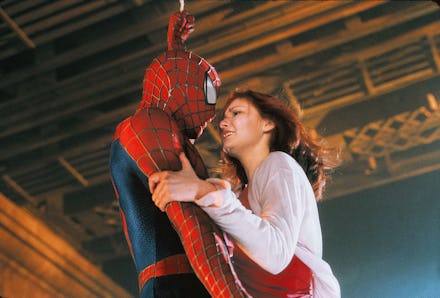The 2002 version of 'Spider-Man' is the best superhero movie of all time

Earlier this week, Sam Raimi signed on to direct Doctor Strange in the Multiverse of Madness. Perhaps as a result of this news, and the original Spider-Man coming to Hulu earlier this month, Twitter users spent the week ranking every Spider-Man film iteration to date. Spider-Man 2 emerged as the consensus pick, as it remains an unimpeachable classic. But what if Raimi actually perfected the comic book movie with that film's predecessor, 2002's Spider-Man.
Although it was released in the shadow of September 11th, with adjustments made to its original marketing campaign, Raimi’s finished product was relatively light on jingoism, especially when you consider how far into overt patriotism other Marvel films have gone. Instead, Raimi made one of the most fun, fleet, and imaginative superhero films of all time. No other director has so thoroughly wrestled away their singular style from a major studio, or achieved their source material's curious and rhythmic intimacy.
This surely has a lot to do with Tobey Maguire. He's far and away the best live-action Spider-Man to take on the role. At the start of the movie, Peter Parker is a pathetic puppy-eyed sap who can barely string together a coherent sentence around Kirsten Dunst's Mary Jane. A product of a more innocent time, we saw Maguire’s Peter trailing MJ to the bus stop, imagining smooth conversations and risking it all against “Macho Man” Randy Savage in the ring to win money for a car that might impress her. That this organically moves from Mary Jane barely knowing her childhood next-door neighbor in early scenes to the soaking, inverted alleyway kiss scene is thanks to the pair's unrivaled on-screen chemistry.
But Spider-Man's entire supporting cast helped elevate this to something special. Like Willem Dafoe’s elastic presence as Norman Osborn, cackling and barking his way through an identity crisis. There’s no better moment than him smashing a glass, sauntering up to the mirror and breaking in and out of character as Norman and the Goblin. J.K. Simmons was so commanding as J. Jonah Jameson, the original militant, stingy journalism boss, that the studios had no choice but to bring him back across franchises. Raimi-favorite Bruce Campbell and Savage, who fully commit to caricatured, exaggerated performances that delightfully tread the line of camp.
Compared to the apocalyptic undertones of more recent Marvel films, the stakes of Raimi’s Spider-Man feel deliriously quaint. There's the climactic sequence that places Green Goblin atop the Queensboro bridge, with Mary Jane in one hand and a tram car full of children in the other. It’s a simple enough setup: save the one you love, or a greater number of children you’ve never met. There’s never a doubt that everyone will make it out of this — they sold toys for this movie, after all — but it solidifies that the lives of a few will always make for more compelling dramatic fodder than thousands of anonymous casualties.
Unlike most every superhero movie that followed, Raimi imbued his trilogy with the visual language of comic books. During each of the first two films, the villain gets a clean body horror transformation showcase, complete with terrified victims. Alfred Molina’s Doc Ock inspires zoomed-in, blood-curdling screams and screeching nails from nurses in Spider-Man 2. Norman Osborn’s disastrous PED infusion led to pained close-ups for his poor assistant, Dr. Stromm. This knack for grafting memorable images is a far cry from the dreary grays of Avengers: Endgame's finale, and explains how it's endured as an internet phenomenon.
But Spider-Man's power also comes from its narrowed ambition. This was a fully contained story, divorced from a network of 20 other films and TV programs that would become essential to comprehend modern superhero movies. Although it would spawn two sequels with an increasing number of villains and camp overtones, the stakes rarely elevated too much further beyond just two or three guys facing off in a public forum. Raimi's first offering struck the balance between the sublimely fun and small doses of gravitas better than anything that would follow. Movies for kids, and adults who wish they were kids, should never be afraid to get this silly and loose.